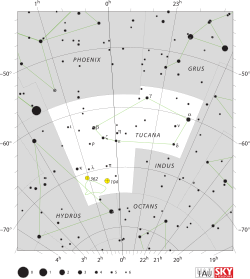| Constellation | |
 List of stars in Tucana |
|
| Abbreviation | Tuc[1] |
|---|---|
| Genitive | Tucanae |
| Pronunciation | /tjʊˈkeɪnə/, genitive /tjʊˈkeɪniː/ |
| Symbolism | the Toucan |
| Right ascension | 0 h |
| Declination | −65° |
| Quadrant | SQ1 |
| Area | 295 sq. deg. (48th) |
| Main stars | 3 |
| Bayer/Flamsteed stars |
17 |
| Stars with planets | 4[2] |
| Stars brighter than 3.00m | 1 |
| Stars within 10.00 pc (32.62 ly) | 2[3] |
| Brightest star | α Tuc (2.87m) |
| Nearest star | LHS 1208 (26.55 ly, 8.14 pc) |
| Messier objects | None |
| Bordering constellations |
Grus Indus Octans Hydrus Eridanus (corner) Phoenix |
| Visible at latitudes between +25° and −90°. Best visible at 21:00 (9 p.m.) during the month of November. |
|
Tucana is a constellation of stars in the southern sky, created in the late sixteenth century. Its name is Latin for the toucan, a South American bird. This is not a prominent constellation as all of its stars are third magnitude or fainter; the brightest is Alpha Tucanae at apparent visual magnitude 2.87.
The recommended three-letter abbreviation for the constellation, as adopted by the International Astronomical Union in 1922, is 'Tuc'.[1] The official constellation boundaries, as set by Eugène Delporte in 1930, are defined by a polygon of 10 segments. In the equatorial coordinate system, the right ascension coordinates of these borders lie between 22h 08.45m and 01h 24.82m, while the declination coordinates are between –56.31° and -75.35°.[4]
Contents |
History [link]
The constellation was one of twelve created by Petrus Plancius from the observations of Pieter Dirkszoon Keyser and Frederick de Houtman.[5] It first appeared on a 35-cm diameter celestial globe published in 1597 (or 1598) in Amsterdam by Plancius with Jodocus Hondius. The first depiction of this constellation in a celestial atlas was in Johann Bayer's Uranometria of 1603.[6]
In 1998, part of the constellation was the subject of a two-week observation program by the Hubble Space Telescope, which resulted in the Hubble Deep Field South.[7]
Notable features [link]
Stars [link]
Beta Tucanae consists of a group of six stars that may be loosely gravitationally bound into a system. The two brightest components, Beta-1 Tucanae and Beta-2 Tucanae, are separated by an angle of 27 arcseconds and have apparent magnitudes of between 4 and 5. They are (probably) accompanied by a third star, Beta-3 Tucanae, which is further away, separated by 9 arcminutes from them.
Kappa Tucanae is a group of four stars: two binary stars.
Lambda Tucanae is an optical double - that is, the name is give to two stars which appear close together from our viewpoint, but are in fact far apart in space. The two stars are known as Lambda 1 and Lambda 2. Lambda 1 is itself a binary star, with two components.
Deep-sky objects [link]
At the southern end of Tucana lies the Small Magellanic Cloud, a dwarf galaxy that is one of the nearest neighbors to the Milky Way galaxy at a distance of 210,000 light-years. Though it probably formed as a disk shape, tidal forces from the Milky Way have distorted it. Along with the Large Magellanic Cloud, it lies within the Magellanic Stream, a cloud of gas that connects the two galaxies.[8]
The globular cluster 47 Tucanae (NGC 104) is located within its boundaries at a distance of 15,--- light-years. Mostly composed of old, yellow stars, it does possess a contingent of blue stragglers, young stars that are hypothesized to form from binary star mergers.[8]
The Tucana Dwarf galaxy, which was discovered in 1990, is also in Tucana. NGC 346 is a star forming region.
References [link]
- ^ a b Russell, Henry Norris (October 1922), "The New International Symbols for the Constellations", Popular Astronomy 30: 469, Bibcode 1922PA.....30..469R
- ^ These are HD 4308, HD 215497, HD 221287 and HD 7199.
- ^ These are Zeta Tucanae and LHS 1208.
- ^ "Tucana, constellation boundary", The Constellations (International Astronomical Union), https://www.iau.org/public/constellations/#tuc, retrieved 2012-01-02
- ^ Ridpath, Ian (1989), Star tales, James Clarke & Co., pp. 9–10, ISBN 0-7188-2695-7, https://books.google.com/books?id=gFrdcTdeVaEC&pg=PA10
- ^ Sawyer Hogg, Helen (October 1951), "Out of Old Books (Pieter Dircksz Keijser, Delineator of the Southern Constellations)", Journal of the Royal Astronomical Society of Canada 45: 215, Bibcode 1951JRASC..45..215S
- ^ Cristiani, S.; D'Odorico, V. (October 2000), "High-Resolution Spectroscopy from 3050 to 10000 Å of the Hubble Deep Field South QSO J2233-606 with UVES at the ESO Very Large Telescope", The Astronomical Journal 120 (4): 1648–1653, arXiv:astro-ph/0006128, Bibcode 2000AJ....120.1648C, DOI:10.1086/301575
- ^ a b Wilkins, Jamie; Dunn, Robert (2006). 300 Astronomical Objects: A Visual Reference to the Universe. Buffalo, New York: Firefly Books. ISBN [[Special:BookSources/978155407175333|978155407175333]].
- Ian Ridpath and Wil Tirion (2007). Stars and Planets Guide, Collins, London. ISBN 978-0-00-725120-9. Princeton University Press, Princeton. ISBN 978-0-691-13556-4.
External links [link]
|
||||||||
|
||||||||||||||
| Wikimedia Commons has media related to: Tucana |
https://wn.com/Tucana
Tucana (disambiguation)
Tucana may refer to:
See also
Tucana (Chinese astronomy)
The modern constellation Tucana is not included in the Three Enclosures and Twenty-Eight Mansions system of traditional Chinese uranography because its stars are too far south for observers in China to know about them prior to the introduction of Western star charts. Based on the work of Xu Guangqi and the German Jesuit missionary Johann Adam Schall von Bell in the late Ming Dynasty, this constellation has been classified as one of the 23 Southern Asterisms (近南極星區, Jìnnánjíxīngōu) under the name Crane (鶴, Hè) and Bird's Beak (鳥喙, Niǎohuì).
The name of the western constellation in modern Chinese is 杜鵑座 (dù juān zuò), meaning "the cuckoo constellation".
Stars
The map of Chinese constellation in constellation Tucana area consists of :

